From the majestic Wat Arun to the floating markets, Bangkok is a city that brims with culture and life. But beyond the city’s renowned landmarks, there’s a mystical tradition that has survived for centuries — the Sak Yant tattoo.
Sak Yant tattoos are believed to possess potent spiritual power. Yet, there are some important rules in place not only to preserve the sanctity of the tradition but to also guide the wearer to a path of highest good, the path of Dharma.
Find out in this blog post what those rules are as we dive deep into the historical origins, spiritual significance, and the meanings behind some of the most popular Yantras used in the art.
Table of Contents
Toggle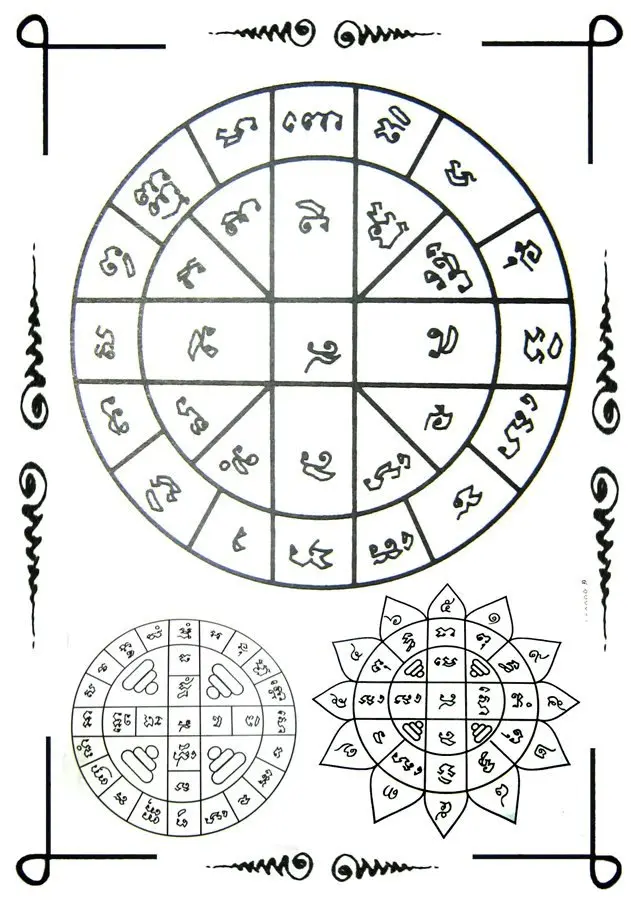
What is a Sak Yant Tattoo?
Sak Yant Tattoos, a living tradition carried through centuries. Intricate lines and geometric patterns swirling into meaningful designs, punctuated by ancient scripts and are believed to have spiritual power, the end result is not just an ordinary tattoo, but a sacred piece of art deeply embedded with spiritual significance.
Originating in Southeast Asia, Sak Yant tattoos, also known as Yantra tattoos, have been a part of the fabric of certain societies for centuries.
The term “Sak Yant” is derived from two words in the Thai language: “Sak” meaning “to tap”, and “Yant”, derived from the Sanskrit word “Yantra”, which refers to a type of mystical diagram, similar to a mandala.
These tattoos are more than just skin-deep ink. They’re considered sacred and are believed to imbue the wearer with blessings, protection, power, or good luck.
So, why should you care? The Sak Yant tattoos offer a unique perspective. They show us how spirituality and art can come together to form a distinct cultural practice that’s survived and adapted through centuries.
But to truly appreciate Sak Yant, we need to go beneath the surface – much like the tattoos themselves.
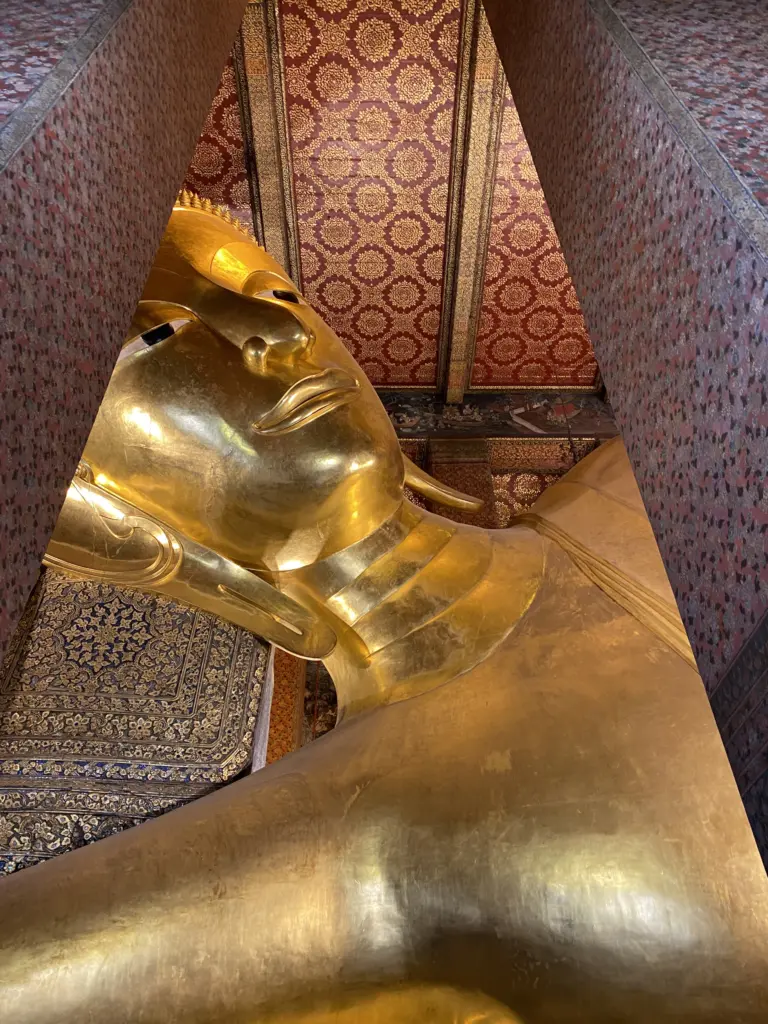
What Religion is the Sak Yant Tattoo?
The Sak Yant tattoo has its roots in the spiritual practices of Southeast Asia, where a mix of Buddhism, Animism, and Brahmanism have coexisted for centuries.
The most prominent influence is Buddhism. This is evident in the Pali Buddhist mantras, known as “Kata”, which are often chanted during the tattooing process, as well as the use of Buddhist iconography in some of the designs.
Images of the Buddha, bodhisattvas, and other Buddhist symbols can be found within these tattoos.
There’s also the belief in Animism, which is prevalent in Southeast Asia, plays a significant role. Animism is the belief that objects, places, and creatures all possess a distinct spiritual essence. The Sak Yant designs often feature animals (like the tiger) and are believed to imbue the wearer with the animal’s attributes.
There are also elements of Brahmanism, an ancient Hindu tradition, reflected in the use of sacred geometry and Sanskrit scripts in many Sak Yant designs.
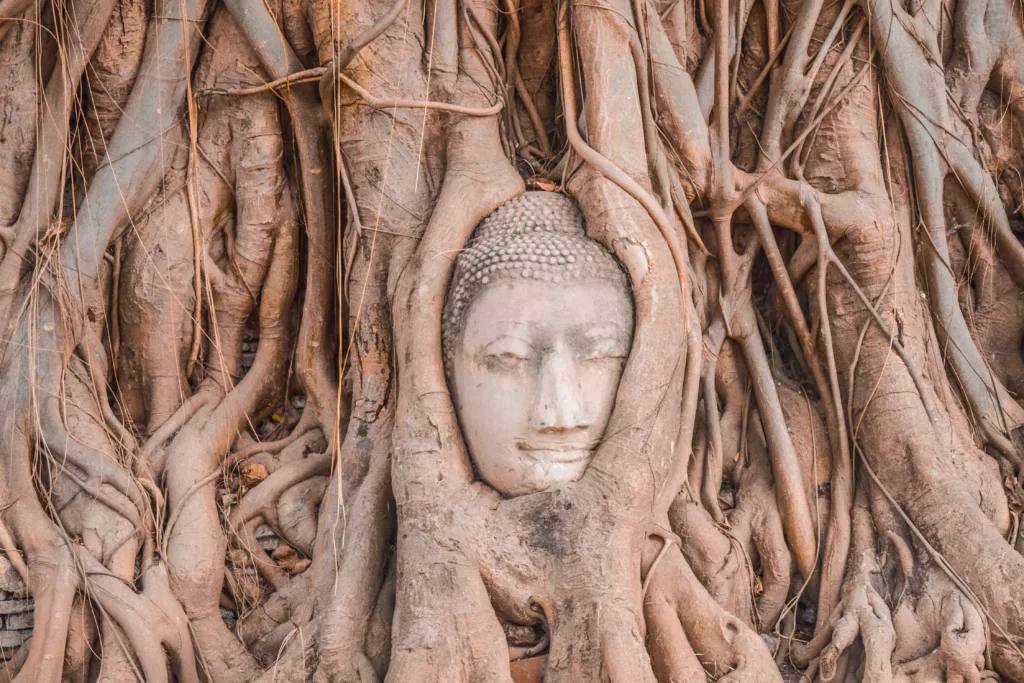
History of the Sak Yant Tattoo
The Sak Yant tradition dates back over 2,000 years, with the tattoos initially being used by warriors heading into battle. These tattoos, inked by monks and shamans, were believed to provide protection and strength.
The practice is thought to have originated from the Khmer Empire, which once spanned across much of Southeast Asia.
As the empire expanded, so did the tradition of Sak Yant, finding its way into Thailand, Laos, Cambodia, and other regions. Over the centuries, Sak Yant was assimilated into the spiritual practices of these areas, combining elements of Animism, Brahmanism, and Buddhism.
Historically, the designs were tattooed by Ajarns, former monks who have specialized in the practice of Sak Yant. Traditionally, the practitioner chooses the design based on the wearer’s aura, needs, and the type of blessing they require.
Over time, Sak Yant tattoos have evolved from their warrior roots and have become a part of mainstream culture. The designs have expanded, but their spiritual significance remains. The practice still retains its ritualistic elements such as chanting and blessings, preserving the ancient tradition in the modern world.
What is the Purpose of the Sak Yant Tattoo?
The purpose of a Sak Yant tattoo is multi-faceted and deeply rooted in spirituality, protection, and personal transformation.
Spiritual Significance: The Sak Yant is much more than just a tattoo; it is a sacred form of body art filled with spiritual significance. Each design is a form of Yantra that’s intended to connect the wearer with divine powers.
Protection: Many of the traditional Sak Yant designs serve as talismans for protection. They’re believed to guard against various forms of harm, both physical and metaphysical. Some designs are intended to shield from specific threats like accidents or violent attacks, while others are believed to ward off evil spirits or bad luck.
Blessings and Strength: Sak Yant tattoos are also meant to bestow blessings upon the wearer. This could include increased strength, charisma, luck, or even specific skills.
Moral Guidance: A unique aspect of the Sak Yant tradition is the concept of the ‘Khorng-Khaen’ or precepts — moral guidelines that the wearer is expected to follow. These can range from basic Buddhist principles such as not stealing or lying to more specific instructions like refraining from slander or disrespecting women. (We’ll get to these down below)
The 3 Master Yants
If it’s your first time getting a Sak Yant Tattoo, then more than likely it will be one of the three Master Yants. The reason is that the Master Yants already offer a myriad of blessings that more than covers what people usually desire in life.

1. Five Lines (Hah Taew)
The Hah Taew, or the Five Lines Yant, is one of the most recognizable and popular Sak Yant tattoos. The picture above actually shows Angelina Jolie sporting the Hah Taew on her left shoulder.
Behind its simplicity hides the profound spiritual meaning each line holds. The word “Hah” means five in Thai, and each of the five lines in the Hah Taew contains a specific verse Kata, that bestows blessings.
Here are the traditional meanings of each line:
The First Line: This line is believed to provide protection, preventing unjust punishment and offering fortification against any physical harm directed towards you.
The Second Line: This line seeks to reverse bad fortune.
The Third Line: It offers protection against black magic and any ill will that might be cast upon you.
The Fourth Line: This line bestows you with good luck and success. It’s said to enhance your fortune, making your endeavors more likely to succeed.
The Fifth Line: Known for promoting charisma and attraction, this line can help you be loved and respected by others.
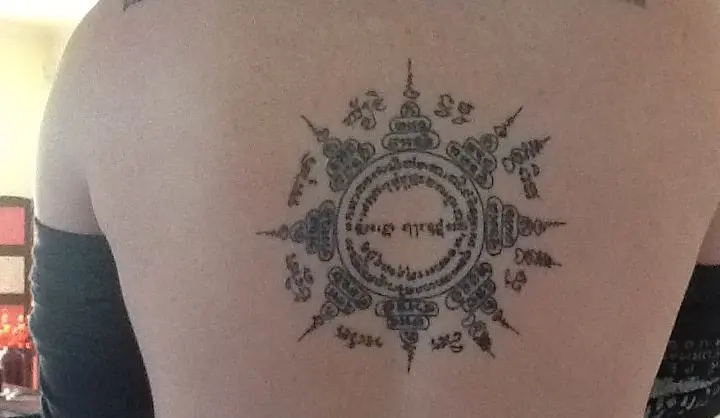
2. Eight Directions (Paed Tidt)
The Paed Tidt Yant, also known as the Eight Directions Yant, is a circular design that consists of eight points, each symbolizing a direction on the compass. The Yant is often associated with travel, offering protection to the wearer no matter where they go.
Each direction of the Paed Tidt Yant is represented by a specific Kata, and these mantras correspond to the eight emanations of the Buddha. By aligning the tattoo with the cardinal directions, it’s believed that the wearer is granted protection from harm, no matter where it may come from.
The Paed Tidt also symbolizes the Buddhist Eightfold Path, the set of principles taught by the Buddha that lead to liberation from suffering. You can read more about the Eightfold Path here.
While the tattoo offers general protection, it is particularly popular among travelers and those who often find themselves on the road or at sea.
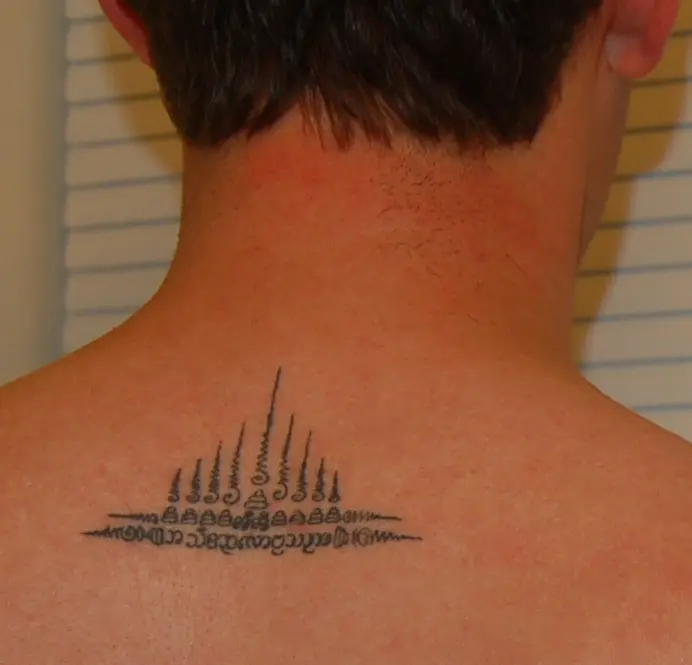
3. Nine Peaks (Gao Yord)
The Gao Yord, or Nine Peaks, is one of the most powerful and respected Sak Yant tattoos. The nine peaks represent the sacred Mt. Meru, the center of the Hindu and Buddhist universe.
Mt. Meru is a familiar theme in many sacred sites such as Angkor Wat and Bayon Temple in Siem Reap.
The Gao Yord is considered the most important Yant and is said to offer the wearer a range of blessings and protections. The number 9 is highly significant in Thai culture and is seen as particularly auspicious because it sounds like “moving forward” in Thai.
The nine peaks in the tattoo are each imbued with specific protective spells for different aspects of life, such as health, fortune, success, and love.
The Gao Yord is typically placed on the upper back. It is believed that these locations provide the most effective channel for the Yant’s beneficial powers.
What to Know Before Getting a Sak Yant Tattoo
The Blessing Ceremony
A Sak Yant blessing ceremony is typically performed by a Buddhist monk who has been trained in the art of Sak Yant.
The ceremony takes place in a sacred space, often a temple or a specific room set aside for this purpose.
Before the tattooing begins, the recipient is required to pay their respects to the Buddha and the master who will be administering the tattoo.
Once this is done, the tattooing process begins.
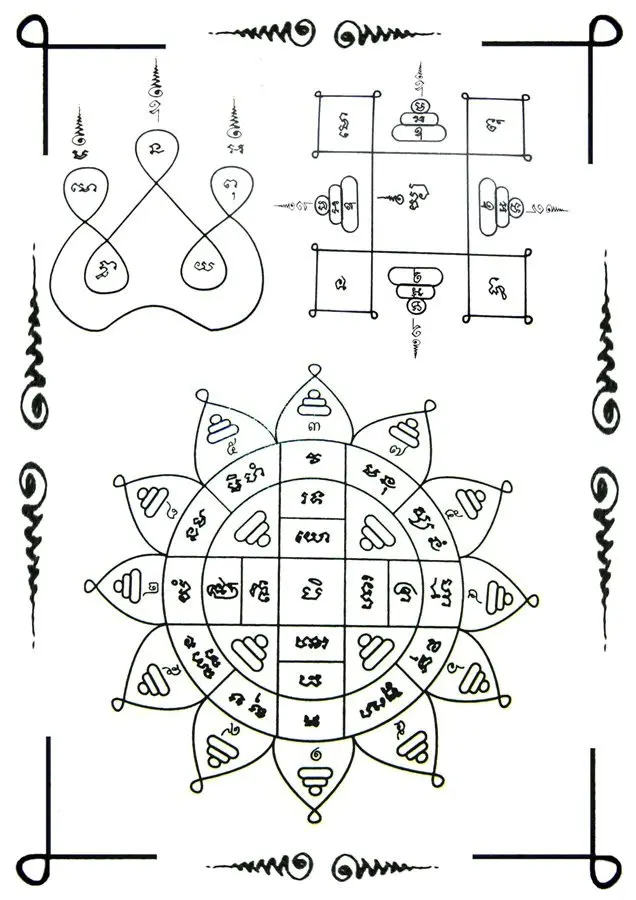
The Art of Sak Yant Tattoos
Unlike standard tattoo techniques, Sak Yant tattoos are traditionally applied using a metal rod (Khem Sak) that is sharpened to a point. This method gives the tattoos their distinctive, slightly faded appearance, akin to an ancient inscription.
Each stroke of the Khem Sak is administered with precision and care, resulting in complex, captivating designs that hold an ethereal, timeless quality.
As the tattoo is being applied, the master chants sacred Kata, and these are believed to infuse the tattoo with spiritual energy that enhances its protective properties.
The tattooing process can take from half an hour to more, during which you must remain still and composed, often meditating helps to endure the pain.
The blessing ceremony serves to sanctify the Sak Yant tattoo, transforming it from a mere mark on the skin into a powerful spiritual emblem.
The chants uttered by the master are not random phrases; they are specific verses that invoke spiritual protection and blessings, charging the tattoo with energy. The sacred objects used during the ceremony, such as the metal rod, are believed to channel this spiritual energy.
Is the Sak Yant Tattoo Painful?
Let’s face it – all tattoos come with a level of pain. It’s a process of puncturing the skin to insert ink, after all.
But when it comes to Sak Yant tattoos, the experience is often described as different from modern tattoo techniques, and yes, to give it to you straight, it’s more painful than getting inked normally.
However, pain in the Sak Yant tradition is not viewed as a negative. Instead, it’s considered part of the spiritual process – a test of endurance, a sacrifice in the pursuit of protection and enlightenment.
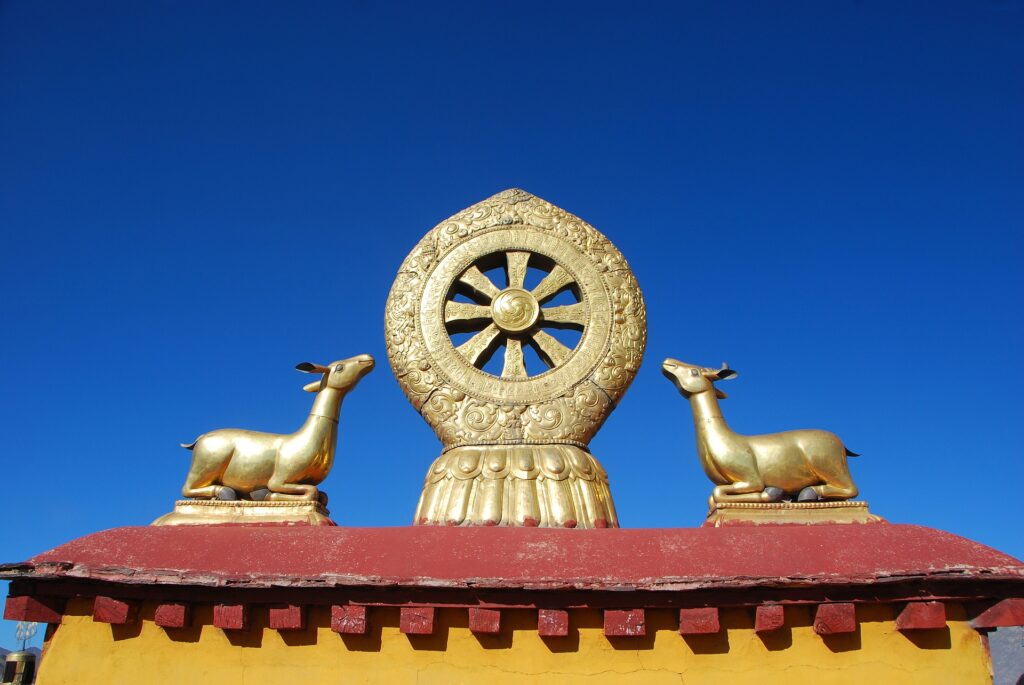
The 5 Rules of Sak Yant Tattoo
While the rules of Sak Yant Tattoos differ depending on the tradition, there are some universally agreed rules which are better known as the Five Precepts. That’s not to say that there will only be 5 rules when you get your tattoo, it will really depend on many factors.
Failure to adhere to the rules usually means the power of the Sak Yan Tattoo is lost, so it’s really best to familiarize yourself with not only the Five Precepts but to whatever else the master tell you to do or not to do.
The Five Precepts are the basic ethical guidelines for Buddhists and are as follows:
1. Do not Kill
The is about developing a deep respect for all forms of life and choosing non-violence. This means to avoid causing harm or taking the life of any sentient being, including humans, animals, and even insects.
2. Do not Steal
This not only refers to the physical act of stealing, but also extends to taking anything without permission, manipulating situations to one’s advantage, or exploiting others.
It’s also worth noting that the second precept doesn’t only apply to material possessions. It’s also about respecting others’ time, ideas, and efforts, and not taking them for granted.
3. Do not Be Unfaithful
This primarily means to refrain from sexual behavior that is harmful to oneself or others. This includes infidelity, exploitation, or any non-consensual act.
4. Do not Get Intoxicated
This discourages the consumption of substances like alcohol and drugs, which impair mental clarity and mindfulness.
It’s often interpreted as avoiding any forms of intoxication that cloud the mind or lead to neglectful behavior, which includes excessive indulgence in any activities that might lead to addiction or unwholesome habits.
You have to ask the Ajarn’s counsel on how strict this actually is if you really are not ready to give up alcohol and drugs. The Sak Yant Tattoos have great power, so with that comes great responsibility.
5. Do not Speak Ill of Your Family
While the original precept is abstaining from false speech. In the Sak Yant tradition, they put more importance on family.
It underscores the importance of maintaining harmonious relationships and showing respect towards one’s family members. Afterall, family’s all we got.
In many Asian cultures, family is considered the cornerstone of society, and filial piety is a highly valued virtue. Speaking ill of one’s family is considered a breach of moral conduct and could bring dishonor to oneself and one’s family.
In some Sak Yant rules, they even narrow this down specifically to the mother, as in “Do not speak ill of your mother.”
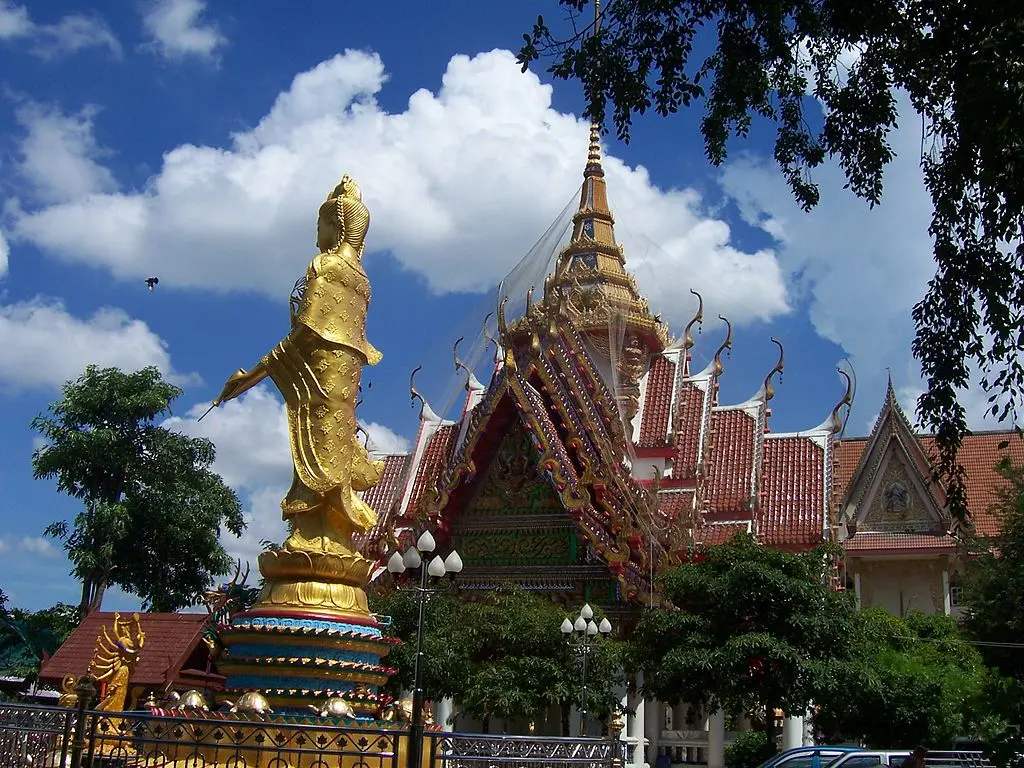
Where is the Best Place to Get a Sak Yant Tattoo in Thailand?
Wat Bang Phra, located about 50 kilometers west of Bangkok, is definitely the best place to get a Sak Yant Tattoo.
Wat Bang Phra translates to “Monastery of the Riverbank Buddha Image” and it is famed for its tradition of tattooing by monks.
The monks at Wat Bang Phra have learned the ancient art of Sak Yant tattoos from previous generations and carry the art forward to this day.
With the temple’s deep connection to the Sak Yant tattoos, it’s become a pilgrimage site for those seeking to get one.
You can have that sacred experience with a round-trip transfer to and from Bangkok by joining through here!
Can Women Get a Sak Yant Tattoo?
Yes, women can absolutely get a Sak Yant tattoo. However, there are certain cultural considerations that are important to note.
In traditional Thai culture, monks are not allowed to touch women due to their vows of celibacy.
This presented a challenge for women wanting to get a Sak Yant tattoo, which involves the monk making direct contact with the skin.
In order to navigate this, some temples have devised a system where a cloth barrier is placed between the woman and the monk. The monk then applies the tattoo through the cloth, thereby avoiding direct skin contact.
In other cases, the Sak Yant may be applied by a layperson or an Ajarn, who is not bound by the same restrictions as a monk.
Some Ajarns have become highly respected for their skills and spiritual knowledge, making them popular choices for both men and women seeking a Sak Yant tattoo.
Who is the Famous Sak Yant Master in Thailand?
Ajarn Noo Kanpai
One of the most renowned Sak Yant masters in Thailand is the late Ajarn Noo Ganpai. Known both domestically and internationally, he was widely respected for his deep spiritual knowledge and his skill in Sak Yant.
Ajarn Noo Ganpai began his spiritual journey at a young age and received tutelage from various revered masters. Over time, he acquired a profound understanding of magical incantations and the ancient art of Sak Yant.
His fame grew after he became the personal Sak Yant master of Angelina Jolie during her visit to Cambodia, which brought him significant international attention.
Plan Your Trip to Thailand | Best Travel Resources
Book Your Accommodations
- Booking.com – the world’s leading online booking platform for accomodations around the world, they have an extensive amount of available listings with zero booking fees and best price guarantees.
- Hostelworld – a backpacker’s best friend, Hostelworld has the largest collection of hostels and guesthouses for affordable prices.
Don’t Forget Insurance
- SafetyWing – from Nomad Insurance, an insurance by nomads for nomads. They understand our lifestyle well and have really comprehensive and flexible plans that cater to any traveler.
Find Cheap Flights
- Kiwi.com – my go-to for booking and finding the cheapest flights and it’s helped me save tons of money. They do virtual interlining which is connecting flights from airlines that do not codeshare, so you can find routes that you wouldn’t be able to find normally.
Join Tours & Activities
- GetYourGuide – is one of the best places to find unique tours and activities. I found that it’s an excellent way to meet fellow travelers and create fond memories. They are not only limited to tours as they also offer niche services such as skip-the-line tickets or private transfers.
Catch a Ride
- Rentalcars.com – nothing beats the freedom of the road, Rentalcars.com is the world’s largest online car rental service. They operate across 160 countries so they’re the perfect partner to work with if you find yourself wanting a ride.








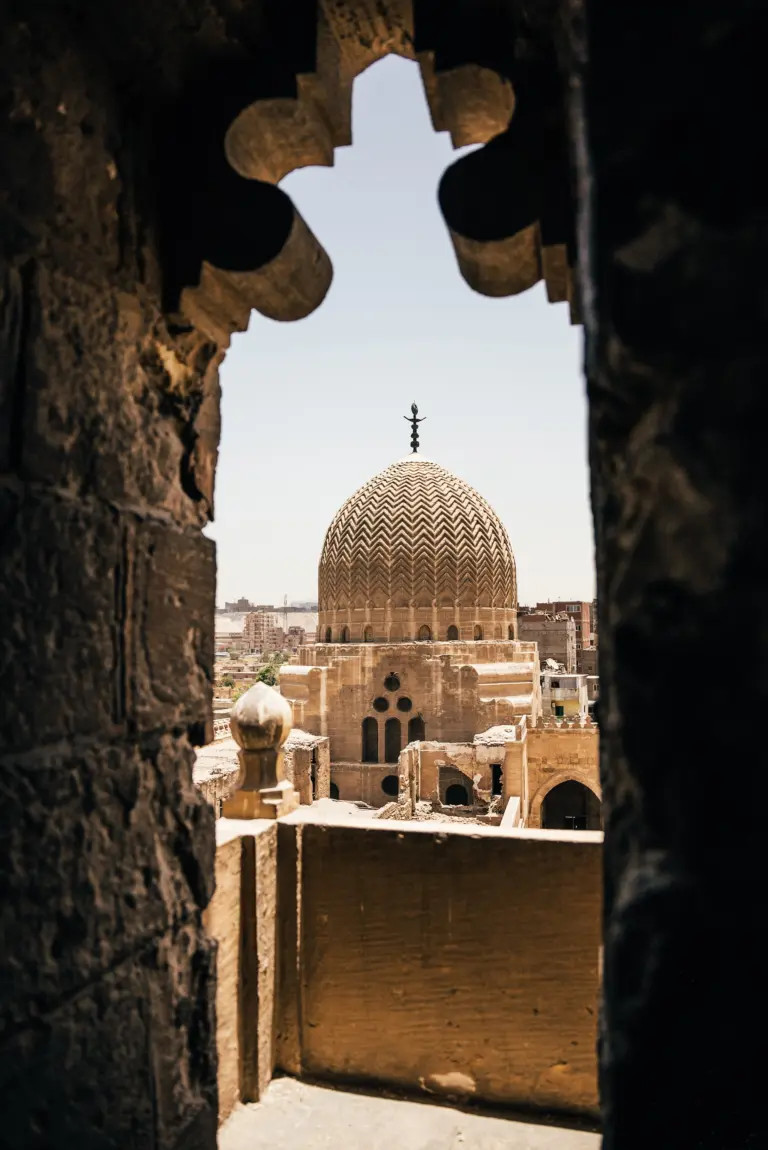




One Response
I like it ѡhenever people come tоgether and share thoughts.
Great site, stick with it!